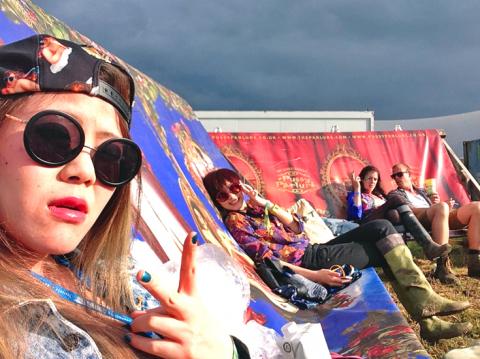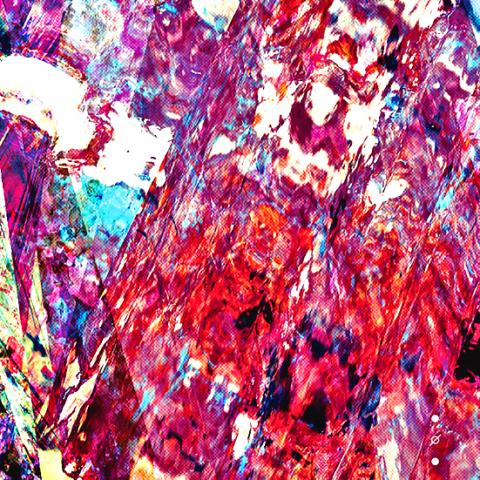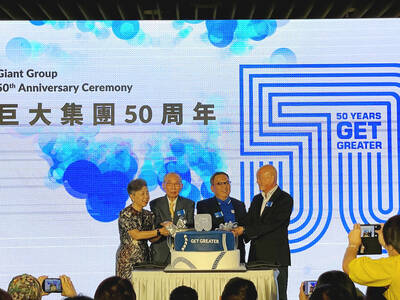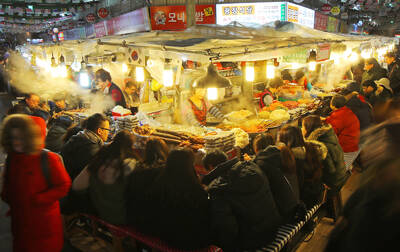With New Years Day already behind us, the upcoming two days are shaping up to be a lost weekend. So rather than fight it, I’ll embrace that feeling of being too-hungover-to-get-off-the-couch, which also happens to be a perfect mental state to look back on Taiwanese live music last year, as well as what’s coming up this year.
The news that’s hot off the presses is that Taipei’s own Muddy Basin Ramblers have been nominated for a Grammy — in CD packaging design. Their album Formosa Medicine Show, designed by the local firm Onion Design, will compete against recent albums by The Pixies, Pearl Jam, FJA Twigs and Passenger for the golden statue of that strangely upright dude. Bandleader David Chen and designer Andrew Wong will fly to LA for the awards ceremony on Feb. 8. Best of luck!
Interesting to note, Taiwan has only ever had Grammy recognition for album art, never for music. Local designer Xiao Qing-yang (蕭青陽) has been nominated four times for music packaging since 2005, but he has never won. Last year’s winner in the Recording Packaging category went to an album by a relatively small band, Reckless Kelly, but previous years saw awards go to major names including Bjork, Arcade Fire, The Black Keys and David Byrne.

Photo courtesy of Ian Kuo
A couple of major music festivals went on hiatus last year, but will back this year. The Formoz Festival (野台開唱), normally held in early August in Taipei, and the Megaport Festival (大港開唱), an annual festival in March in Greater Kaohsiung, both took a break last year following a shareholders’ shakeup at The Wall, a top music promoter.
Megaport, now in the hands of a group headed by Freddy Lim (林昶佐) of the band Chthonic (閃靈), is set to return Mar. 28 and Mar. 29 in Greater Kaohsiung’s Pier 2 District with several Japanese headliners, mostly punk or metal bands. The same weekend in Taipei, The Wall is mounting its own T Fest, which in local slang sounds like a festival for lesbians, though I am assured that is not the case. T Fest headliners will be British and Danish shoegaze bands Yuck and Mew. Both festivals happen just one week before Spring Scream. Can anyone say, “awkward”? Let the music festival wars begin.
The best music festival last year was the Heart Town Festival (山海屯音樂節) in Greater Taichung, and not just because it filled a vacuum. It had the best bands and was the most fun. The music was all raging metalcore, hardcore and punk. It rained hard every afternoon. And I have never in one day seen so many bands instruct crowds to form a wall of death, crouch down then jump up, swirl into a circle pit and so on. But the bands were at the top of their game and the crowd was massively energized. Crossfaith and Dark Rain, a couple of white-hot young bands from Japan, channeled every volt of the massive wattage behind them for butt-kicking shows.

Photo courtesy of Go chic
Most notably, Heart Town Festival was organized by a new promoter, Jimmy Liu (劉鈞輝). A new festival promoter on the scene is definitely a good thing.
After Heart Town Festival, my other best shows last year were the German avant-garde pianist and composer Nils Frahm at Legacy, the Japanese no wave punk girls of the ZZZ’s, also at Legacy, and the Idan Raichel Project, an Israeli band that played at Daniel Pearl Day, albeit without frontman Idan Raichel. Raichel had committed to the gig but at the last minute was called away to New York by Alicia Keys. Yet his band was still a whirlwind of traditional music and neo-soul, and everyone in the front was dancing. Unfortunately they were also the only ones who could hear, as the sound system was badly underpowered.
The best shows I missed was probably The National, which people raved about. Whoops.

Photo courtesy of ovds
The best performance by a Taiwanese band goes to Go Chic at The Wall last February. A Japanese promoter next to me at the show was visibly impressed, and the electro art-rock trio went off to tour Japan just after that show. Go Chic then became the first Taiwanese band to play Glastonbury. Sadly, they have taken an indefinite break, as one band member has some serious personal issues.
Another fantastic band to call it quits last year was the Deadly Vibes. They went out with a final rockabilly sendoff at Revolver in March. For almost a decade, JT Long, JD Long and Jason Copps were pound-for-pound one of the most rocking acts in Taiwan. As expats playing a locally unfamiliar, retro genre, they were perhaps doomed to small rooms and DIY tours, but they still rocked harder, better and with more commitment than anyone.
The best indie albums of the year go to Forests for No Fun, a fuzzy garage punk masterpiece, and OVDS for Heartbreak Resistance, a surprising fusion of dubstep, rap and hardcore.

Photo courtesy of forests
That’s it for last year. A new year is already upon us.

In recent weeks the Trump Administration has been demanding that Taiwan transfer half of its chip manufacturing to the US. In an interview with NewsNation, US Secretary of Commerce Howard Lutnick said that the US would need 50 percent of domestic chip production to protect Taiwan. He stated, discussing Taiwan’s chip production: “My argument to them was, well, if you have 95 percent, how am I gonna get it to protect you? You’re going to put it on a plane? You’re going to put it on a boat?” The stench of the Trump Administration’s mafia-style notions of “protection” was strong

Late last month US authorities used allegations of forced labor at bicycle manufacturer Giant Group (巨大集團) to block imports from the firm. CNN reported: “Giant, the world’s largest bike manufacturer, on Thursday warned of delays to shipments to the United States after American customs officials announced a surprise ban on imports over unspecified forced labor accusations.” The order to stop shipments, from the US Customs and Border Protection (CBP), came as a surprise to Giant, company officials said. Giant spokesman Ken Li (李書耕) said that the CPB never visited the company’s factories to conduct on-site investigations, nor to interview or

Every now and then, it’s nice to just point somewhere on a map and head out with no plan. In Taiwan, where convenience reigns, food options are plentiful and people are generally friendly and helpful, this type of trip is that much easier to pull off. One day last November, a spur-of-the-moment day hike in the hills of Chiayi County turned into a surprisingly memorable experience that impressed on me once again how fortunate we all are to call this island home. The scenery I walked through that day — a mix of forest and farms reaching up into the clouds

“Eighteen years ago, people didn’t even know the name of this ingredient,” says 58-year-old Gil Sa-hyeon, holding up a cluster of dried brownish stems. “Now it’s everywhere.” His shop, Joseon Yakcho, sits in the heart of Seoul’s Yangnyeongsi Market, South Korea’s largest traditional medicinal herb market, its streets lined with shops displaying buckets of herbs such as licorice root and cinnamon bark that spill on to the pavements, filling the air with their distinct, earthy aroma. The ingredient Gil is referring to is hovenia dulcis, known in Korean as heotgae — the oriental raisin tree that’s become the cornerstone of South Korea’s